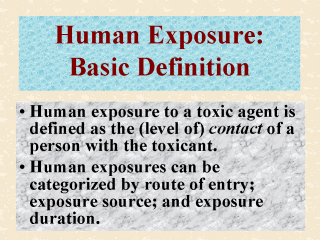| front |1 |2 |3 |4 |5 |6 |7 |8 |9 |10 |11 |12 |13 |14 |15 |16 |17 |18 |19 |20 |21 |22 |23 |review |
 |
All study
designs discussed in textbooks of epidemiology (and in the last two slides as well) can be
used to assess or measure human exposures to some degree. Although it is one of the
central components of health risk assessment, human exposure assessment is not covered in
any great length in (many) textbooks of toxicology. This does not mean that toxicologists
are not qualified to perform human exposure assessment. As a matter of fact, many forensic
and clinical toxicologists are required by their occupation to determine the amount of
toxic substance present in human bodies. However, their focus appears to be more on
individuals, not on groups. Human exposure to a toxic agent is defined simply as the (level of) contact of a person with the toxicant. Dose on the other hand is the amount of that toxicant that is present in (or sometimes even on) a person at specific time intervals. As to be discussed more extensively in Lectures 7 and 8, there are several types of human exposures that epidemiologists have to deal with. In terms of route of entry, human exposures to toxic agents can be subdivided into primarily the following three categories: oral, inhalation, and dermal. Human exposures can also be categorized according to their sources: outdoor, indoor, occupational, residential, postapplication (reentry), passer-by, ambient air, dietary, drinking water, etc. These different types of human exposures can be further qualified according to their duration: acute, short-term, intermediate, long-term, chronic, and lifetime. |